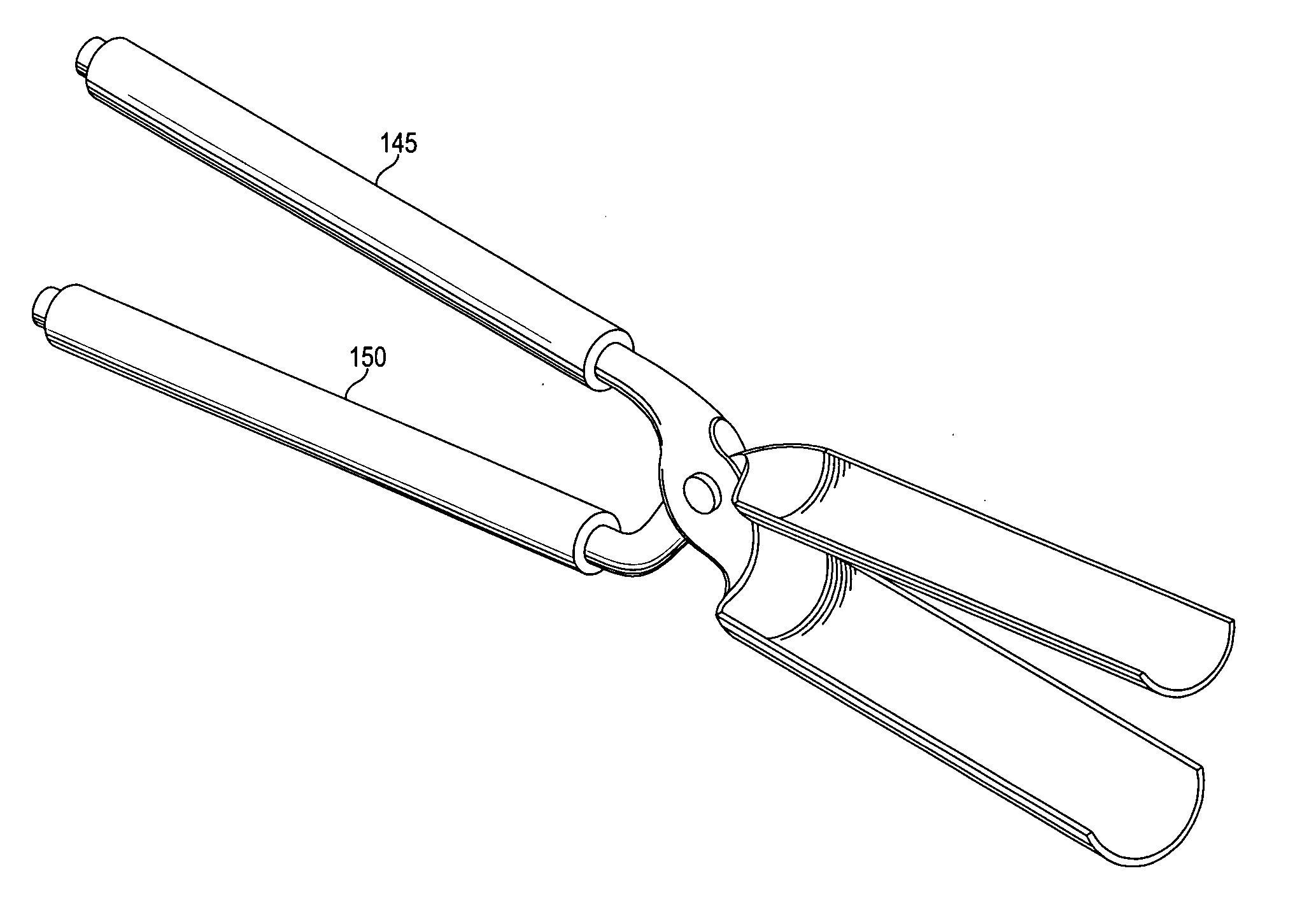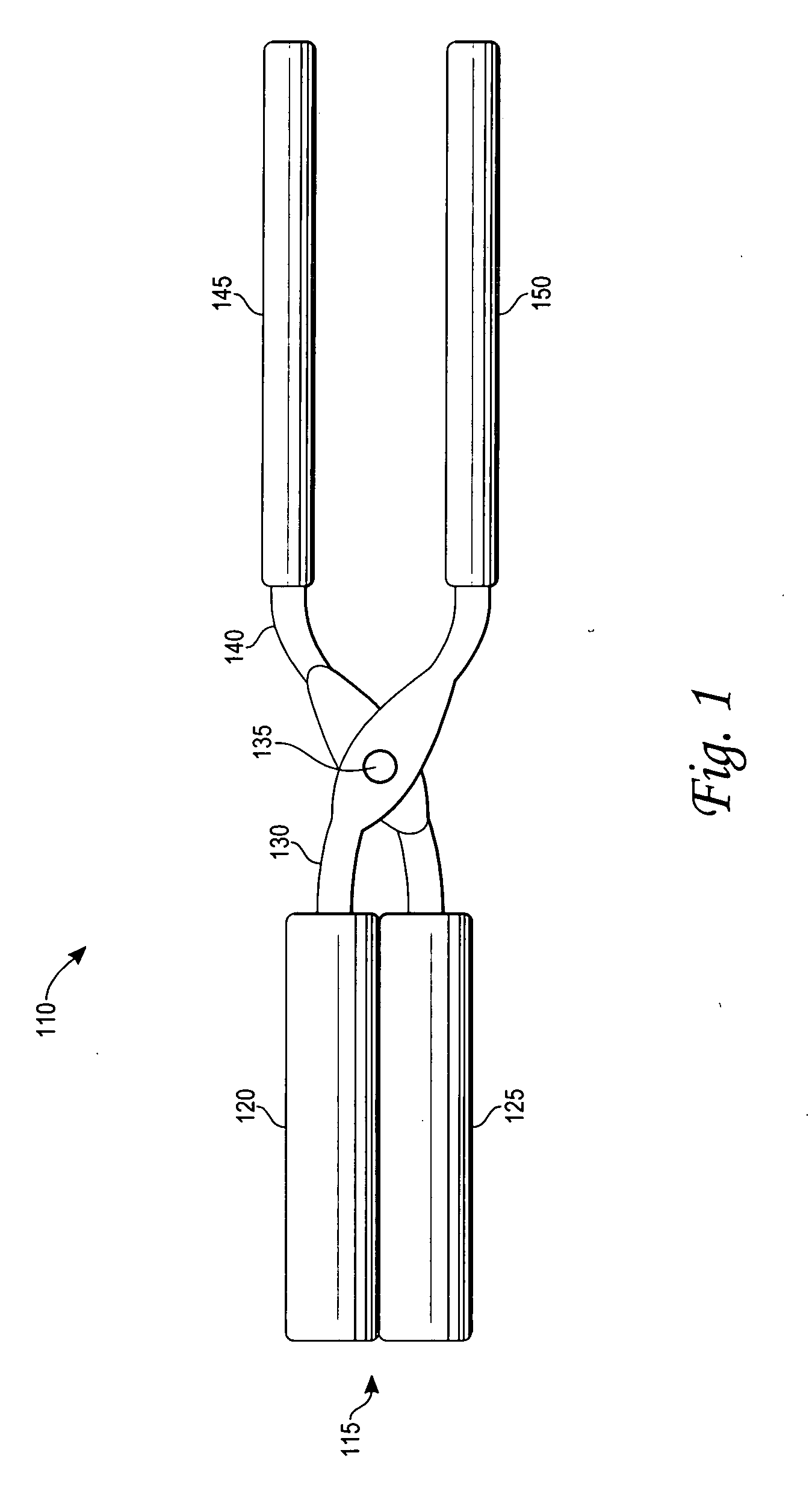Hair Iron
a curling iron and hair technology, applied in curling irons, curling-tongs, hair equipments, etc., can solve the problems of affecting the use of curling irons, and eroded consumer confidence in electrically heated curling irons, so as to prevent hot spots on the heating surface, evenly and predictably distribute hea
- Summary
- Abstract
- Description
- Claims
- Application Information
AI Technical Summary
Benefits of technology
Problems solved by technology
Method used
Image
Examples
first embodiment
[0031] The first embodiment as seen in figure one shows the hair iron 110 having an upper handle sleeve 145 and a lower handle sleeve 150 enveloping a pair of handles 140 and pivotally cooperating at a pivot junction 135 also called the clip assembly point. The clip extension protrudes from the clip assembly 135 and terminates in a pair of barrels. The upper barrel 120 is parallel to a lower barrel 125 and forms a pair of tong blades 115.
[0032] A pair of tong blades include a first tong blade and a second tong blade the upper barrel may have a semicircular cross section comprising a ceramic core enveloped in a metal jacket mounted on the first tong blade. The lower barrel may have a semicircular cross section comprising a ceramic core enveloped in a metal jacket mounted on the second tong blade. The upper and lower barrels meet to form an interface for holding hair to be straightened, while an upper handle and a lower handle form a pair of handles. The clip assembly pivotally joins ...
second embodiment
[0035] A second embodiment shown in FIG. 4 includes a single barrel 440 cooperating with a lower blade. The lower blade is curved and formed of rigid metal planar material and does not contain ceramic heat emitting material. The barrel holds a strand of hair and can curl hair wrapped around the outside circumference of the barrel. The cross sectional view shown in FIG. 5 provides a curved hair travel path. The ceramic material shown in FIG. 5C has a large cross section and is thus capable of retaining a substantial amount of heat.
[0036] The second embodiment shows what is typically referred to as a “curling iron.” Not only does the second embodiment allow a user with straight hair waves and curls, it also provides volume for those with finer hair. The size of the cylinder that makes up this tool is crucial; the larger the circumference of the cylinder, the larger the curls become. The curling iron with the larger cylindrical circumference produces bigger waves, while the curling iro...
third embodiment
[0037] the present invention includes the device shown in figure six and seven. The lack of a ceramic core in the upper and lower blade allow a user to cool hair, or present limited heat for hair. As seen in the cross sectional view of FIG. 7. The upper blade fits into the lower blade forming a curved path for hair. The curved path is useful in a variety of cosmetology implementations.
[0038] The third embodiment in FIG. 7 represents a tool that can serve as both a curling and straightening device. Since using the curling iron may improperly create angular creases at its ends, this tool is useful to smooth creases while leaving a curly accent to the ends. The third embodiment of the invention can also be used after blow-drying to smooth hair, similar to the effects of the flat iron, of the first embodiment. The crescent design of this tool however, will leave a slight wave rather than dull and straight ends. This tool can also be used to flip a user's hair outwards. This would be a p...
PUM
 Login to View More
Login to View More Abstract
Description
Claims
Application Information
 Login to View More
Login to View More - R&D
- Intellectual Property
- Life Sciences
- Materials
- Tech Scout
- Unparalleled Data Quality
- Higher Quality Content
- 60% Fewer Hallucinations
Browse by: Latest US Patents, China's latest patents, Technical Efficacy Thesaurus, Application Domain, Technology Topic, Popular Technical Reports.
© 2025 PatSnap. All rights reserved.Legal|Privacy policy|Modern Slavery Act Transparency Statement|Sitemap|About US| Contact US: help@patsnap.com



